深度学习--GAN学习笔记
生成模型
什么是生成模型?
- GMM: 用来做聚类,(非监督学习)
- NB(朴素贝叶斯):(监督学习,可以用来做垃圾邮件分类)
- Logistics 回归是生成模型吗?No!
生成模型与解决的任务之间没有必然的联系,关注的是样本本身。对于监督学习\(p(x, y)\) , 非监督学习 \(p(x,z)\) , 有些模型甚至仅用 \(X\) , 成为 Autoregression model 。
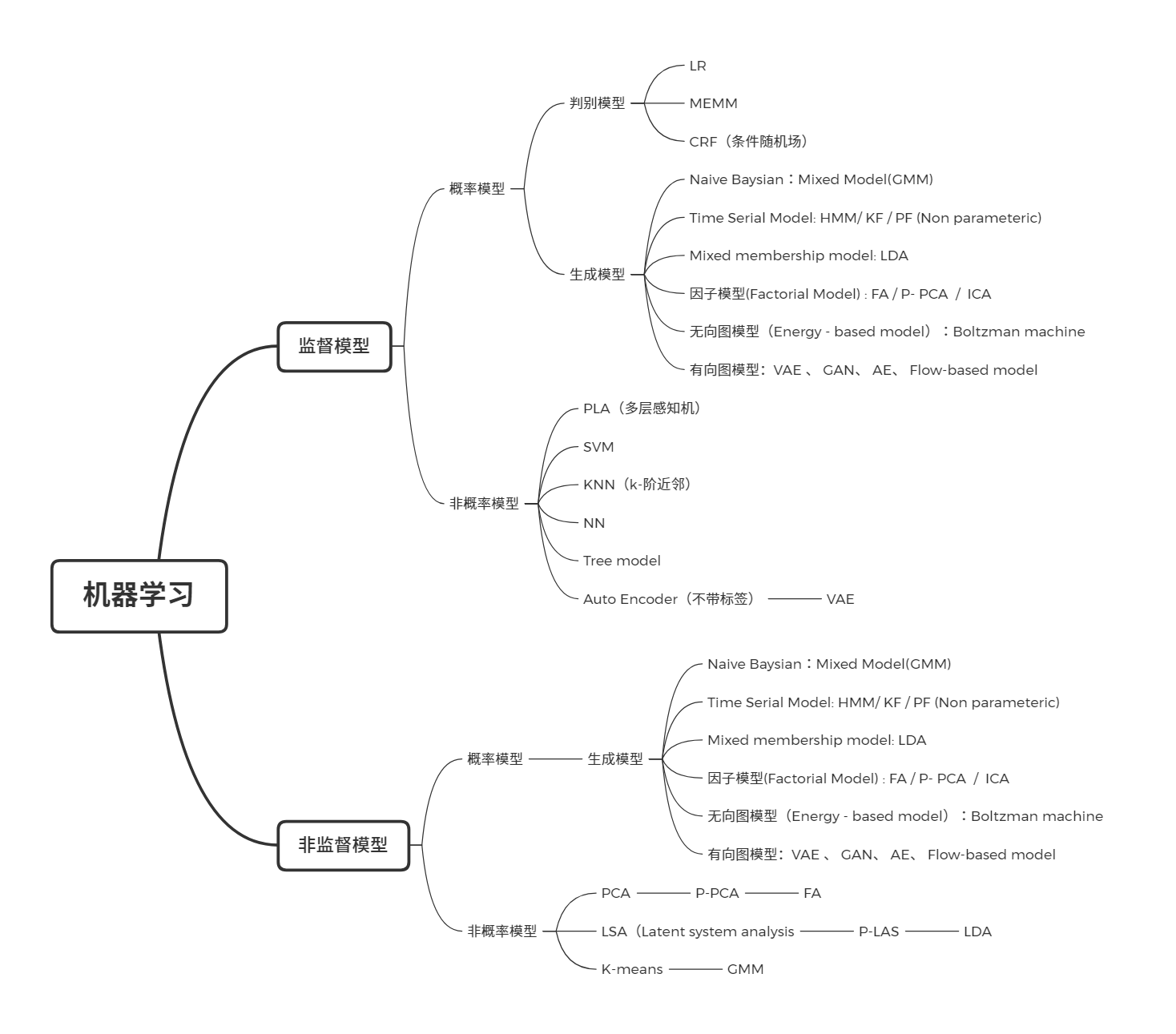
GAN(生成式对抗网络)

- 工艺大师的目的:成为高水平,可以以假乱真的大师。($P_g \rightarrow P_d $)
如果用统计模型去刻画这个模型,如何去表示?模型中的生成器和判别器可以通过一些模型去表示。
GAN的流程:
- Initialize the generator and dicriminator
- In each traning iteration
- Step 1 : Fixed generator G , and update discriminator D.
- Step 2 : Fixed Discriminator D , and update generator G ;
Auto - Encoder
A[Random Generator] -->C(N.N)
F(A vector as code) --> C(N.N Decoder)
C --> D[N.N Decoder] -->G[Image]
VAE
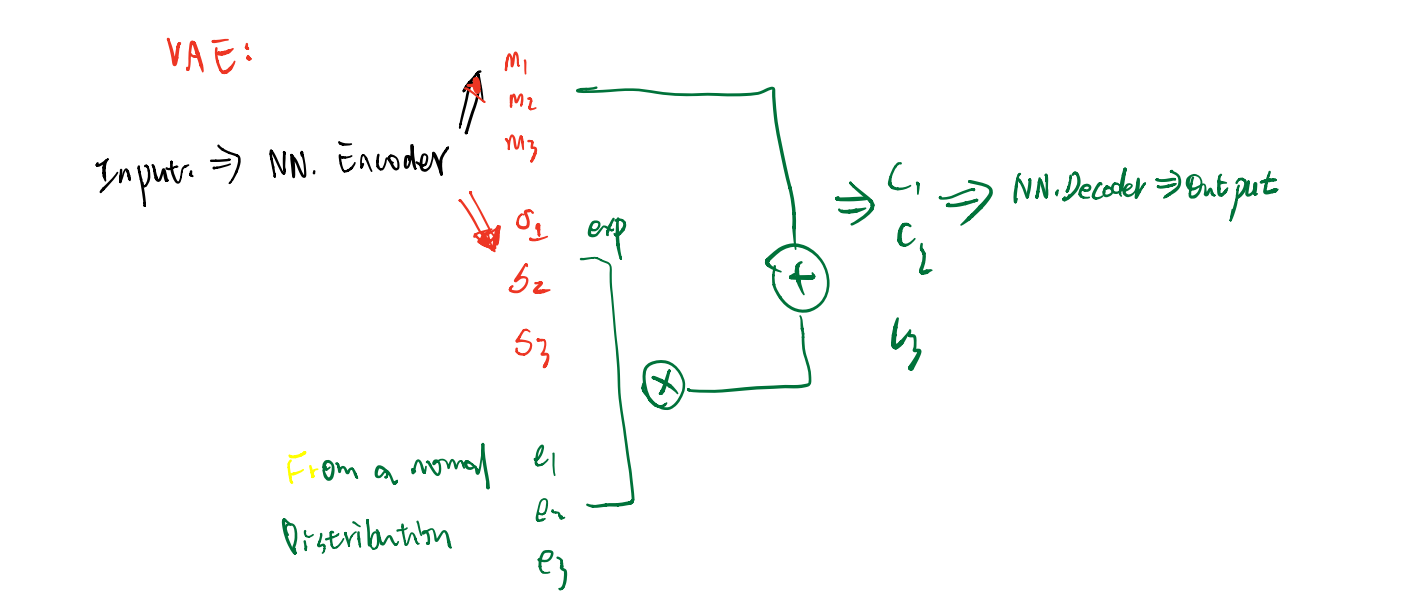
这里会对 \(\sigma\) 进行限制:
\]
VAE存在着一些问题:它不能真的尝试去模拟真的图像
GAN——数学表示
数学符号:
\(\{x_{i}\}_{i}^{N}\) 样本数据
\(P_{data}:\) Population Density
\(P_g(x;\theta_{g}):\) 生成模型的density; 可以用
NN进行逼近\(z \sim P_{Z}(Z)\) , Proposed Density,一般用来生成 \(\tilde{x}_{i}\)
\(D(Z) = D(\tilde{x},\theta_{d}):\) 表示 Discrimination 识别是否是“国宝”的概率,越接近于1,越可能是国宝
\(\tilde{x} = G(z;\theta_g)\)
A[Z] -->B(N.N)
B --> C{N.N}
F(P_data) --> C{N.N}
C -->|YES| D[国宝]
C -->|NO| E[赝品]
G[Z]-->H(N.N)-->I(tilde_x)
对于高专家来说:
- 如果 \(x\) 是来自于 \(P_{data}\) , 我们可以发现 \(D(x;\theta_{d})\)是较大的 \(\Longrightarrow\) \(\log(D(x;\theta_{d}))\) 是较大点的;
- 如果 \(x\) 是来自于 \(P_{generator}\) , 我们可以发现 \(D(x;\theta_{d})\)是较小的 \(\Longrightarrow\) \(1 - D(x;\theta_{d})\)是较大点的\(\Longrightarrow\) \(\log(1 -D(G(Z))\)是较大的;
所以对于高专家的目标函数为:
\]
对于高级技师来说,想以假乱真:
- 如果 \(x\) 是来自于 \(P_{generative}\) , 我们可以高级技师希望 \(D(x;\theta_{d})\)是较大的 \(\Longrightarrow\) \(\log(1 -D(G(Z))\)是较小的;
\]
所以在这个体系中,总的目标为:
\]
小结:GAN的复杂度在于模型的学习,我们并没有直接面对\(P_g (x , \theta_{g})\) ,而是用神经网络去逼近\(P_g (x , \theta_{g})\) ,所以GAN是一种 Implict Density Model 。
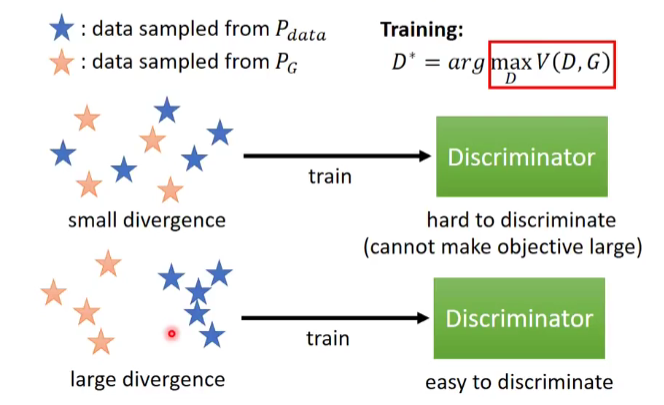
GAN存在最优解吗?
一般来说,我们会从MLE (Maximum Likelihood Estimation) 角度去解目标函数,但在GAN模型中,我们可以不通过MLE,而通过神经网站逼近Prob Density。

f-divergence
Definition: P and Q are two distribution . \(p(x)\) and \(q(x)\) are the probability of sampling of sampling x.
\]
Remark : \(f\) function is convex , \(f(1) = 0\) , \(D_{f}({P||Q})\) evaluates the differences of P and Q.
- if \(p(x)\) = \(q(x)\) for all \(x\), \(D_{f}({P||Q}) = 0\) ; if \(p(x) = q(x)\) for some \(x\) ,
\[D_{f}({P||Q})= \int_{x} q(x) f \left( \frac{p(x)}{q(x)}\right) dx \geq f \left[ \int_{x} q(x) \cdot \frac{p(x)}{q(x)} dx \right] = 0
\]
Fenchel Congjugate
every conex function \(f\) have a Congjugate function \(f^{*}\);\(f^{*}\) also is a convex function . We can find that \((f^{*})^{*} = f\)
\[f^{*}(t) = \max_{x \in dom (f)} {xt - f(x)} \Longleftrightarrow
f (x) = \max_{t \in dom (f^{*})} {xt - f^{*}(t)}
\]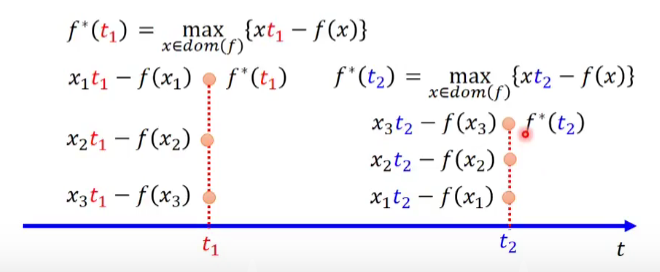
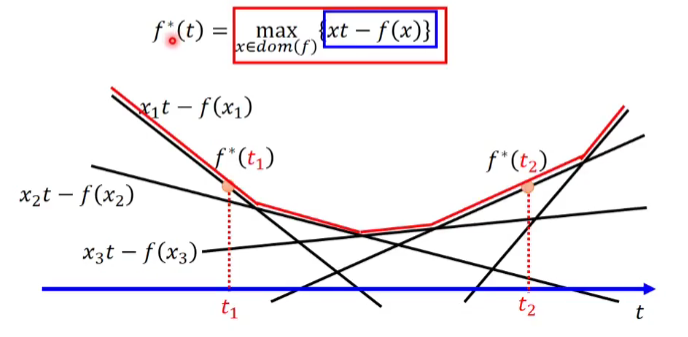
if \(f(x) = x \log x\) , \(f^{*}(t) = e^{t-1}\)

D_{f}(P||Q) & = \int_{x} q(x)f\left( \frac{p(x)}{q(x)}\right) dx \\
& = \int_{x} q(x) \left[ \max_{t \in dom(f)}
\left( \frac{p(x)}{q(x)} t - f^{*} (t) \right) \right]dx \\
& \approx \max_{D} \int_{x} p(x)D(x)dx - q(x)f^{*}\left(D(x) \right) dx
\end{aligned}
\]
Where \(t = D(x)\) ; D is a function , whose input is \(x\) , Output is \(t\)
D_{f}(P||Q) & \ge \int_{x} q(x) \left[
\left( \frac{p(x)}{q(x)} D(x) - f^{*} \left(D(x) \right) \right) \right]dx \\
& = \int_{x} p(x)D(x)dx - q(x)f^{*}\left(D(x) \right) dx
\end{aligned}
\]
GAN角度
这里出现了一个问题,我们并不知道 \(P_{g}\) 和 \(P_d\) 这两个分布,怎么去求解?在GAN角度中,我们可以通过从 \(p_{g}\) 和 \(p_d\) 中抽样的方法去求解生成器。

站在GAN的角度如何测量KL Div
GAN是从对抗学习的角度,因此我们要思考最优解存在吗?如果存在,\(P_{g} \stackrel{?}{=} P_{d a t a}\)
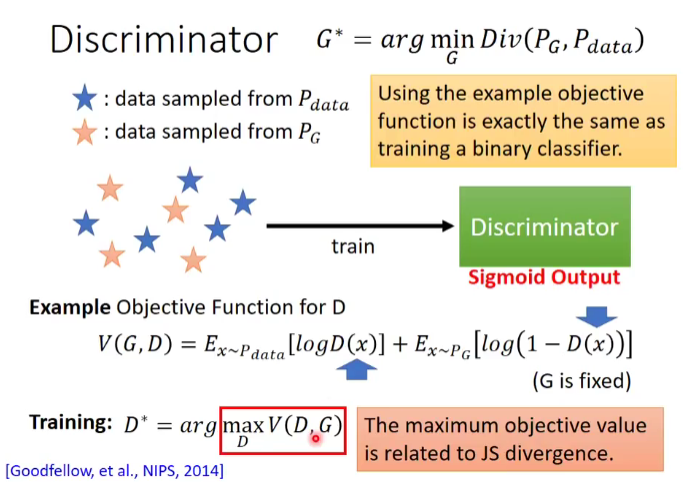
我们引用论文中的符号:
+ E_{x \sim p_{g}} \left[ \log \left( 1 - D\left(X \right )\right) \right]
\]
因此我们的目标函数可以写为:
\]
Asumption:
- \(G(x)\) can be any fuction
求解步骤:
- Step 1 : Given G , what is optimal \(D^{*}\) maximizing
\max_{D} ~ V(D,G) & = \int p_{data} \log \left(D\left(x \right)\right) dx +
\int p_{g} \log \left[ \left( 1- D(x) \right) \right] dx \\
& = \int \left[ p_{data} \log D(x) + p_{g} \log(1-D(x)) \right] dx
\end{aligned}
\]
FOC Condition:
\frac{\partial} {\partial D} V(D,G) & = \frac{\partial }{\partial D}
\left [ \int \left[ p_{data} \log D + p_{g} \log(1-D(x)) \right] dx \right] \\
& = \int \frac{\partial }{\partial D}\left[ p_{data} \log D + p_{g} \log(1-D(x)) \right] dx \\
& = \int \left[ p_{data} \frac{1}{D(x)} + p_{g}
\frac{-1}{1-D(x)}\right] D^{\prime}(x)~ dx \stackrel{\Delta}{=}
0
\end{aligned}
\]
Remark: 这里定积分和求导可以互换顺序,\(D(x) \in [0,1]\), 从FOC条件可以得到:
~ \Longrightarrow ~ D^{*} (x) = \frac{p_{d}}{p_{d} + p_{g}}
\]
- Step 2: 把 \(D^{*}\) 带入目标函数,则有:
\min_{G} \max_{D} V (G,D) & = \min_{G} V (G, D^{*}) \\
& = \min_{G} \rm E_{x \sim p_{d}} \log \left[
\frac{p_{d}}{p_{d} + p _{g}}\right]
+ E_{x \sim p_{g}} \log \left[ \frac{p_{g}}{p_{d}+p_{g}}\right]
\end{aligned}
\]
这个表达式与 KL Divergence 的形式非常像, 可以用 KL来表示吗?p 或 q 为一个Prob Density 。
\]
答案是可以的,需要一些小技巧, $ 0 \le JSD < \le 2$ .
\min_{G} \max_{D} V(G, D) & = \min_{G} \rm E_{x \sim p_{d}} \log \left[
\frac{p_{d}}{p_{d} + p _{G}}\right]
+ E_{x \sim p_{G}} \log \left[ \frac{p_{g}}{p_{d}+p_{G}}\right] \\
& = \min_{G} \rm E_{x \sim p_{d}} \log \left[
\frac{p_{d}}{\left( p_{d} + p _{G} \right) \2} \frac{1}{2} \right]
+ E_{x \sim p_{G}} \log \left[ \frac{p_{G}}{ \left (p_{d}+p_{G}\right) \2}
\frac{1}{2} \right] \\
& = \min_{G} KL[~ p_d || \frac{p_{d} + p_{G}}{2}~] +
KL[~p_g || \frac{p_{d} + p_{G}}{2}~] - \log(4) \\
& = 2JSD(P_{data} ||p_{G} ) - \log4
\end{aligned}
\]
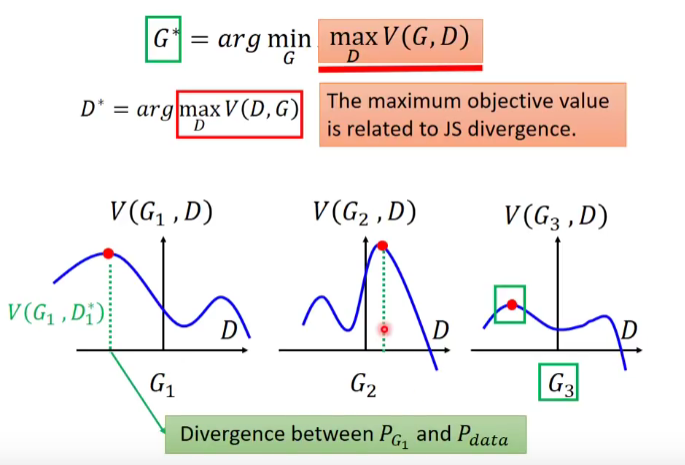
什么时候等式成立?当且仅当 \(p_{d} = p_{G} = \frac{p_d + p_{G} }{2}\) , 可以解出 \(p_{d}^{*} = p_{G }^{*}\) = 0.5 , \(G^{*} = 0.5\),这意味着什么?在最有的情况下,复制出来的工艺品,送给 Discriminator 已经无法识别真假 。
Algorithm:
- Given \(G_{0}\)
- Find \(D_{0}^{*}\) maxmizing \(V(G_{0}, D)\)
- $\theta_{G} \leftarrow \eta ~ \partial V(D,G_{0}^{*}) / \partial \theta_{G} $ \(\Longrightarrow\) obtain \(G_{1}\)
\(V(G_{0}, D_{0}^{*})\) is the JS Divergence between \(p_{data}(x)\) and \(p_{G_{0}}\)
Find \(D_{1}^{*}\) maxmizing \(V(G_{1}, D)\)
- \[\theta_{G} \leftarrow \eta ~ \partial V(D,G_{1}^{*}) / \partial \theta_{G} $$ obtain $G_{2}$
\]
......
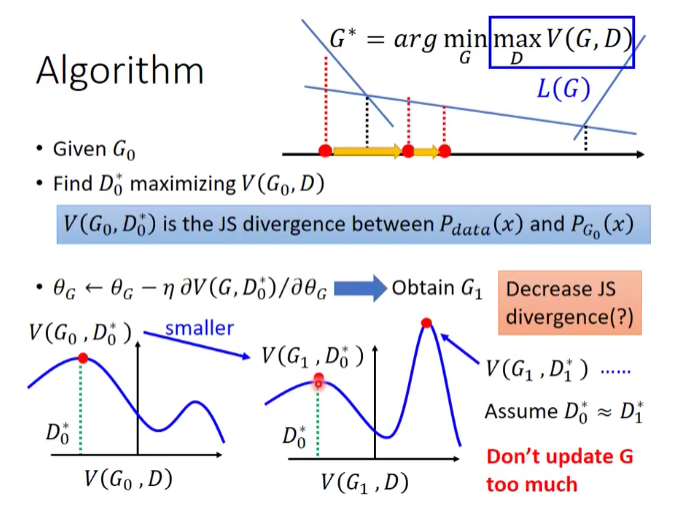
In Practice
Given G , How to compute \(\max V(G, D)\)
- sample {\(x^{1}, x^{2}, \ldots ,x^{m}\)} from \(p_{data}(x)\) , sample {\(\tilde{x}^{1}, \tilde{x}^{2}, \ldots ,\tilde{x}^{m}\)} from \(p_{G}(x)\)
\[\max V = \frac{1}{m} \sum_{i}^{m} \log D(x^{i}) +
\frac{1}{m} \sum_{i}^{m} \left[\log 1 - D( \tilde{x}^{i}) \right]
\]
Remark: In binary classifier , D is the binary classifier with the sigmoid output . {\(x^{1}, x^{2}, \ldots ,x^{m}\)} from \(p_{data}(x)\) can be viewed as positive examples , {\(\tilde{x}^{1}, \tilde{x}^{2}, \ldots ,\tilde{x}^{m}\)} from \(p_{G}(x)\) can be viewed as negative examples. Our goal is to minimize the cross-entropy. this is equal to the \(\max V\)
- sample {\(x^{1}, x^{2}, \ldots ,x^{m}\)} from \(p_{data}(x)\) , sample {\(\tilde{x}^{1}, \tilde{x}^{2}, \ldots ,\tilde{x}^{m}\)} from \(p_{G}(x)\)
Summary
Algorithm:
initialize \(\theta_{d}\) for \(D\) and \(\theta_{g}\) for \(G\)
In each training iterations (k times) :
sample m {\(x^{1}, x^{2}, \ldots ,x^{m}\)} from data distribution \(p_{data}(x)\)
sample m noize {\(z^{1}, z^{2}, \ldots ,z^{m}\)} from prior distribution \(p_{prior}(z)\)
obaining the generated data {\(\tilde{x}^{1}, \tilde{x}^{2}, \ldots ,\tilde{x}^{m}\)} , \(\tilde{x}^{i} = G(z^{i})\)
update discriminator parameters \(\theta_{d}\) to maxmize
\(\max \tilde{V} = \frac{1}{m} \sum_{i}^{m} \log D(x^{i}) +
\frac{1}{m} \sum_{i}^{m} \left[\log 1 - D( \tilde{x}^{i}) \right]\)\(\theta_{d} \leftarrow \eta ~ \Delta \tilde{V}(\theta_{d})\)
以上是测量 JSD, 下面是最小化 JSD , 即 Learning Genarator , 但是不能 train 太多次。
- sample another m noise samples {\(z^{1}, z^{2}, \ldots ,z^{m}\)} from prior distribution \(p_{prior}(z)\)
- update discriminator parameters \(\theta_{g}\) to minmize
- \(\min \tilde{V} = \frac{1}{m} \sum_{i}^{m} \log D(x^{i}) +
\frac{1}{m} \sum_{i}^{m} \left[\log 1 - D \left(G \left( z^{i}\right) \right) \right]\) - \(\theta_{g} \leftarrow \eta ~ \Delta \tilde{V}(\theta_{g})\)
- \(\min \tilde{V} = \frac{1}{m} \sum_{i}^{m} \log D(x^{i}) +
Intution
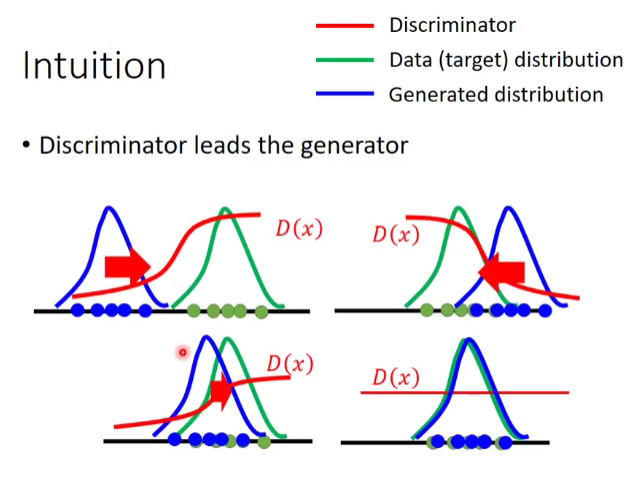
W - GAN
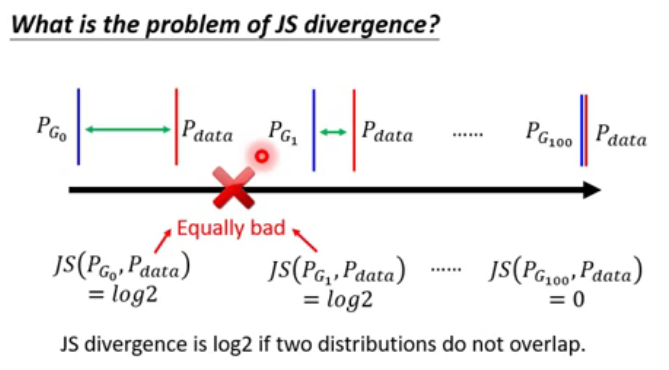
WGAN
Considering one distribution P as a pile of earth , and another distribution Q as a target . The average distance the earther mover has to move the earth .

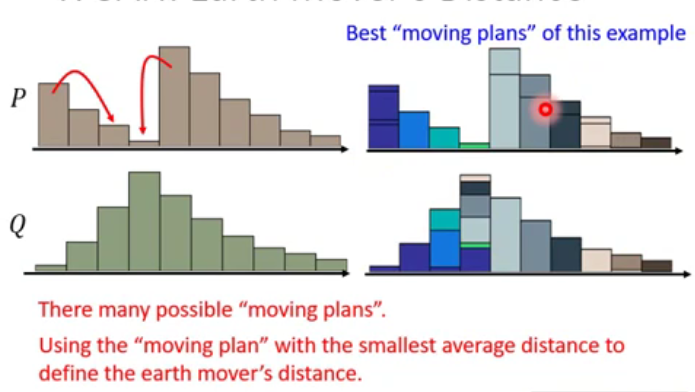
What's the moving plan ?
A "Moving plan " is matrix, the values of the element is the amount of earth from one position to another.
Average distance of a plan \(\gamma\) :
\]
Earth Distance:
\]
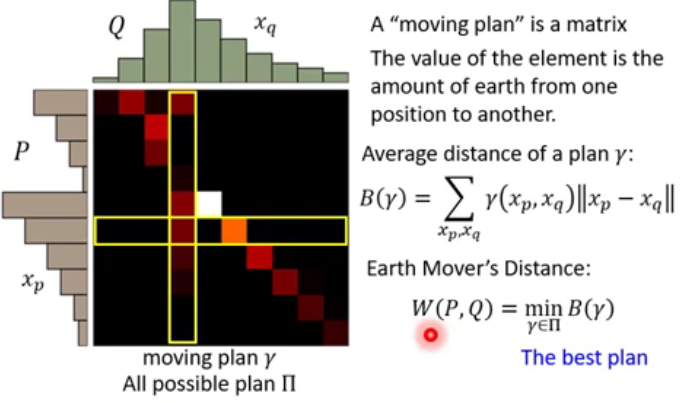
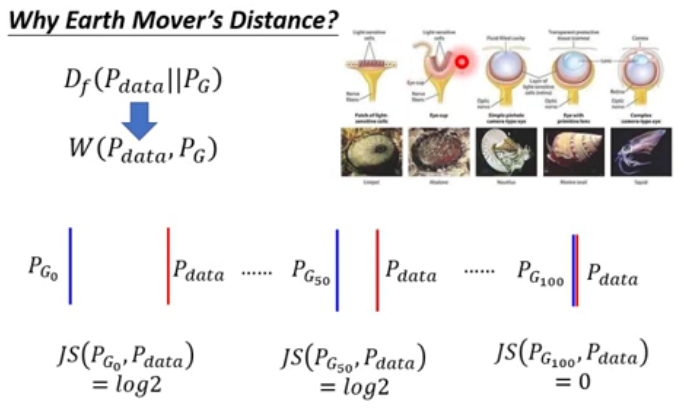
Evaluate the wasserstein distance between \(p_{data}\) and \(p_{g}\); D has to be smooth enough .
\]
Without the constraint , the trainning of D will not converge.
Keep the D smmoth forces \(D(x)\) become \(\infin\) to \(-\infin\)
What's the Lipschitz ?
\[k - Lipschitz ~~ function: ~~||f(x_{1}) - f(x_{2}) \le k ||x_{1}-x_{2}||
\]
How to Solve ?
Weight Clipping : Force the parameters w between c and -c , After parameter update , if \(w > c\) ,\(w = c\); if \(w < - c\) ,\(w = -c\)
深度学习--GAN学习笔记的更多相关文章
- Deep Learning(深度学习)学习笔记整理系列之(五)
Deep Learning(深度学习)学习笔记整理系列 zouxy09@qq.com http://blog.csdn.net/zouxy09 作者:Zouxy version 1.0 2013-04 ...
- Deep Learning(深度学习)学习笔记整理系列之(八)
Deep Learning(深度学习)学习笔记整理系列 zouxy09@qq.com http://blog.csdn.net/zouxy09 作者:Zouxy version 1.0 2013-04 ...
- Deep Learning(深度学习)学习笔记整理系列之(七)
Deep Learning(深度学习)学习笔记整理系列 zouxy09@qq.com http://blog.csdn.net/zouxy09 作者:Zouxy version 1.0 2013-04 ...
- Deep Learning(深度学习)学习笔记整理系列之(六)
Deep Learning(深度学习)学习笔记整理系列 zouxy09@qq.com http://blog.csdn.net/zouxy09 作者:Zouxy version 1.0 2013-04 ...
- Deep Learning(深度学习)学习笔记整理系列之(四)
Deep Learning(深度学习)学习笔记整理系列 zouxy09@qq.com http://blog.csdn.net/zouxy09 作者:Zouxy version 1.0 2013-04 ...
- Deep Learning(深度学习)学习笔记整理系列之(三)
Deep Learning(深度学习)学习笔记整理系列 zouxy09@qq.com http://blog.csdn.net/zouxy09 作者:Zouxy version 1.0 2013-04 ...
- Deep Learning(深度学习)学习笔记整理系列之(二)
Deep Learning(深度学习)学习笔记整理系列 zouxy09@qq.com http://blog.csdn.net/zouxy09 作者:Zouxy version 1.0 2013-04 ...
- Deep Learning(深度学习)学习笔记整理系列之(一)
Deep Learning(深度学习)学习笔记整理系列 zouxy09@qq.com http://blog.csdn.net/zouxy09 作者:Zouxy version 1.0 2013-0 ...
- Deep Learning(深度学习)学习笔记整理系列之(一)(转)
Deep Learning(深度学习)学习笔记整理系列 zouxy09@qq.com http://blog.csdn.net/zouxy09 作者:Zouxy version 1.0 2013-0 ...
随机推荐
- java中jre\bin目录和jdk\bin目录下的工具功能介绍
转自:https://blog.csdn.net/eclipse_yin/article/details/51051096 jre/bin目录下面工具说明 javac:Java编译器,将Java源代码 ...
- 02.SpringMVC之初体验
1.创建Maven WEB项目 2.导入springmvc的jar包 <dependencies> <dependency> <groupId>org.spring ...
- [题解] P4556 [Vani有约会]雨天的尾巴
[题解] P4556 [Vani有约会]雨天的尾巴 ·题目大意 给定一棵树,有m次修改操作,每次修改 \(( x\) \(y\) \(z )\) 表示 \((x,y)\) 之间的路径上数值 \(z\) ...
- linux使用xampp安装MediaWiki环境
1.下载并安装xampp 下载xampp 在下载页面下载. 放置到相应目录 将xampp-linux-x64-5.6.3-0-installer.run文件复制到部署机器的/root目录下 安装 [r ...
- promise的信任问题&控制反转
//信任问题 //第三方的某个库 function method(cb){ setTimeout(function(){ cb && cb(); //这个库的bug:函数被多调用了一次 ...
- Tomcat中的一些问题
问题: 一闪而过,解决办法: 用记事本打开startup.bat文件,在最下面添加pause 再次运行,发现问题 CATALINA_HOME是TOMCAT安装路径的别名, 计算机>属性>环 ...
- 剑指 Offer 31. 栈的压入、弹出序列
剑指 Offer 31. 栈的压入.弹出序列 输入两个整数序列,第一个序列表示栈的压入顺序,请判断第二个序列是否为该栈的弹出顺序.假设压入栈的所有数字均不相等.例如,序列 {1,2,3,4,5} 是某 ...
- Pytest系列(19)- 我们需要掌握的allure特性
如果你还想从头学起Pytest,可以看看这个系列的文章哦! https://www.cnblogs.com/poloyy/category/1690628.html 前言 前面我们介绍了allure的 ...
- ABP 极简入门教程(二 MVC方式显示数据)
增加显示菜单 Sample.Web.MVC项目中找到startup目录打开SampleNavigationProvider.cs,根据现有内容添加以下内容 .AddItem( new MenuItem ...
- JS012. 变量存储含class、id等其他属性的标签元素(动态渲染DOM结点)
项目中有一处源码需要用变量存储html标签,包含类名和其他一些属性,再动态地将其渲染到页面上. 看下普通的存储方式: initHtml: function () { var me = this; // ...
